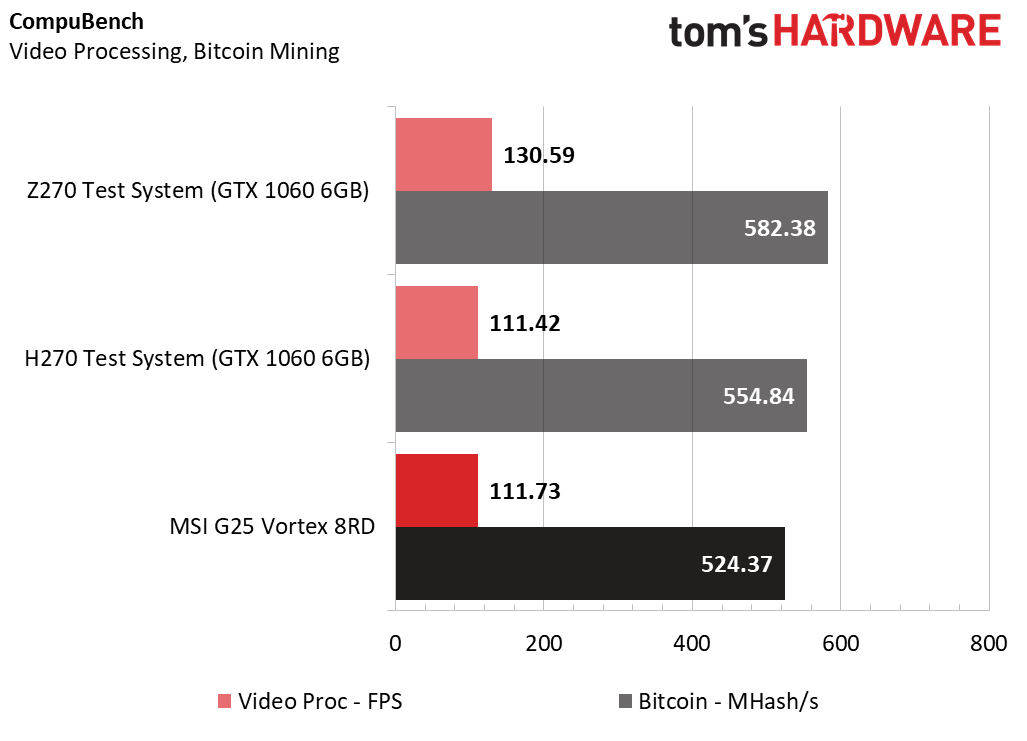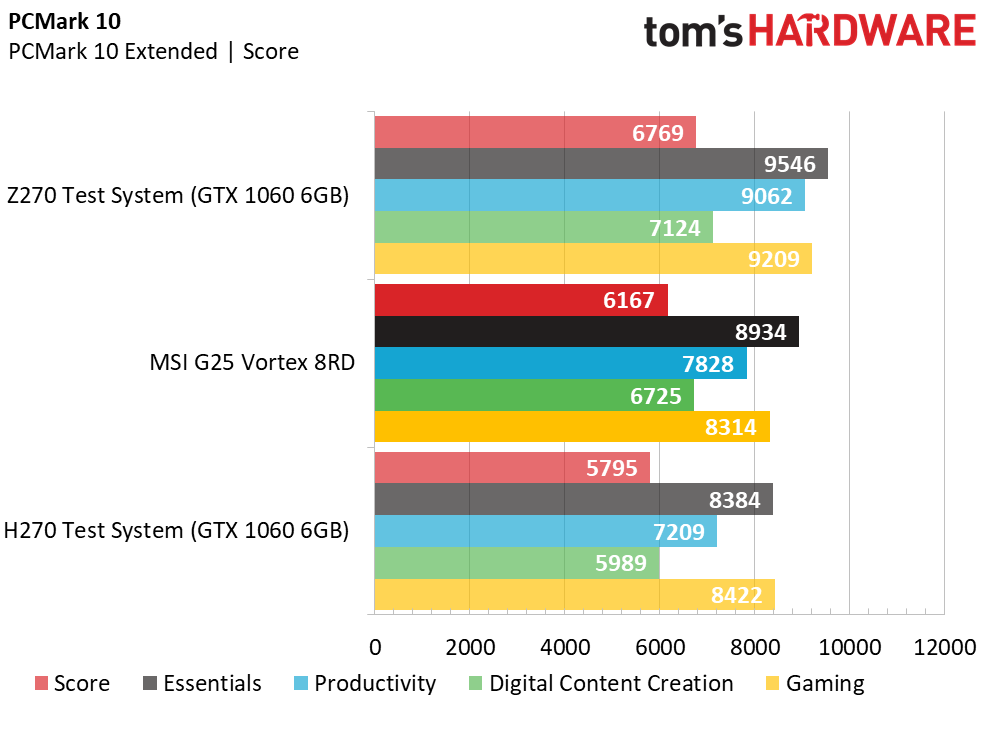MSI G25 Vortex 8RD Gaming PC Review
Why you can trust Tom's Hardware
Synthetic & Productivity Benchmarks
MSI’s G25 Vortex 8RD is one of the first systems we’ve tested that features Intel Coffee Lake processors, so our comparison factors are mostly comprised of previous-generation systems. We happened to have an Intel H270 platform with a Core i5-7500 (the Core i5-8400’s predecessor) on hand, so we set it up and collected data to pit against MSI’s next-gen contender.
Our Z270 test bench features an Intel Core i7-7700K cooled by a Deepcool Gammaxx 400 on an ASRock Z270 Gaming i7 motherboard, with 16GB of Kingston HyperX Savage DDR4-2133 memory, a 1TB HyperX Savage SATA 6 Gb/s SSD, and a 1000W EVGA Supernova G3 power supply.
The H270 test platform sports a Core i5-7500 on an ASRock H270 Performance motherboard. We used the same memory from our Z270 platform, and Kingston shipped us a 512GB Savage SATA 6 Gb/s SSD to use in the reference bench. EVGA also hooked us up with a 650W version of the Supernova G3 power supply for the new test rig. Zotac provided us with a stock-clocked GTX 1060 6GB graphics card, and we used it in both the Z270 and H270 rigs. The full specifications of our comparison systems are listed below.
Test System Configurations
Z270 TEST BED
H270 TEST BED
We tested the MSI G25 Vortex using the presets in its Dragon Center software, with the performance mode set to Sport and the fan curve on Auto (this was how it was originally shipped). Our Z270 and H270 tests systems were both tested with stock CPU and GPU clock speeds and operation, with memory set to DDR4-2133 and a CAS latency of 15-15-15-35.
We also made some changes to our Productivity test suite, adding VRMark and PCMark 10 Extended to our usual list of benchmarks.
Get Tom's Hardware's best news and in-depth reviews, straight to your inbox.
3DMark




The MSI G25 Vortex doesn’t fare too well against its similarly-equipped desktop brethren, netting lower overall, Graphics, and Combined scores across the gamut of 3DMark Fire Strike and Time Spy tests. The main cause of this is the mobile GTX 1060 under the hood; it performs—as we'd expect—slightly behind a desktop version of the graphics card (at stock frequencies). However, the Vortex takes the second place with its Physics and CPU scores throughout the entirety of the tests, with the Core i5-8400 performing better than our Core i5-7500-equipped test rig and just behind the quad-core (8-thread) Core i7-7700K in our Z270 reference machine.
Cinebench R15
With the CPU in the spotlight, the MSI G25 Vortex 8RD takes a more favorable position in the stack, besting our H270 machine (with the previous-gen i5-7500 inside) and falling slightly behind the previous Intel flagship CPU (the i7-7700K). Single-threaded tests put the Vortex only slightly ahead of our H270 rig, but the Core i5-8400 shines with multi-threaded workloads, putting the Vortex within arm's reach of our Z270 (i7-7700K) test bench.
CompuBench
The MSI G25 Vortex returns to the bottom of the pile in the Compubench test results. Although the Vortex manages to (barely) outpace the H270 test rig in the Video Processing test, its weaker mobile GPU loses a little over 20 MHash/s compared to the desktop counterpart inside the H270 machine.
Storage Test


MSI’s use of an M.2 SSD with a SATA controller may seem to be an odd choice, the 256GB Samsung PM871a SATA 6 Gb/s SSD inside the Vortex performs well, achieving just under its rated sequential read speed (of 540 MB/s) at 539.14 MB/s. However, the sequential read and random read and write IOPS performance falls short of the advertised speeds for the drive. Despite this, the SSD performs admirably (it even bests our reference SATA storage in write IOPS), and average consumers will appreciate the speedy primary storage.
Our reference rigs both feature the same brand of SSD, although in different capacities. However, while testing the new H270 machine (with a 512GB HyperX Savage SSD), our storage test results only varied from our Z270 test bench (with a 1TB HyperX Savage SSD) by less than 1%. Because of this, we simply used our data from the Z270 test rig to represent both reference platforms, since the storage is virtually identical in performance, despite the difference in capacity.
Sandra Memory Bandwidth


Predictably, the MSI Vortex falls behind the dual-channel desktop PCs in the field during the Sandra memory bandwidth test. This is due to the Vortex’s single 16GB module of DDR4-2400 SO-DIMM memory, which sports a high CAS latency of 17-17-17-39 (which also doesn’t help its bandwidth performance). Because of this, the MSI G25 Vortex will lag behind systems with dual-channel memory operation in workloads that are bandwidth intensive.
PCMark 8
The Vortex’s speedy storage and processor give it an edge over our H270 reference rig in the PCMark 8 application tests. The Vortex also trails the Z270 platform by a small margin in the Microsoft Office application benchmark, but its Core i5-8400 can’t compete with the higher thread count and clock speeds of our Z270 rig’s i7-7700K in the Adobe Creative application tests.
PCMark 10 Extended
We added the PCMark 10 Extended benchmark to our suite to get a better idea of specific productivity performance across a broad range of application types. The MSI G25 Vortex takes its familiar second-place position over our H270 rig and just behind our Z270 platform, but the Vortex still finishes last in the gaming portion of the test, which uses a version of 3DMark Fire Strike to test the system’s gaming acumen.
VRMark
VRMark tells a similar story: the MSI G25 Vortex falls behind the desktop GPU-equipped competition, despite the differences in CPU horsepower. However, the Orange Room test shows that the Vortex exceeds the minimum recommended performance for the Oculus Rift, but pushing the details higher with the Blue Room test brings all three of the systems in the field to their knees.
MORE: Best PC Builds
MORE: How To Build A PC
MORE: All PC Builds Content
Current page: Synthetic & Productivity Benchmarks
Prev Page Introduction & Product Tour Next Page Gaming BenchmarksDerek Forrest was a contributing freelance writer for Tom's Hardware. He covered hardware news and reviews, focusing on gaming desktops and laptops.
-
Pompompaihn Um.....6 core i5 and 1060 is certainly more than acceptable for 1080p gaming.Reply
So yeah, I'd consider it a gaming PC. -
Strider_X "consumers in the 11-24 demographic will find it aesthetically pleasing"Reply
Interesting comment in the article. I believe the design in more mature than that. Fairly minimalist, no multicolor LEDs, space efficient. I'm twice that age and like to build gaming pc's and this one is an interesting alternative to standard designs.
The lack of dual channel memory and a few other missteps make it less than ideal but I believe there is a market for this form factor.




